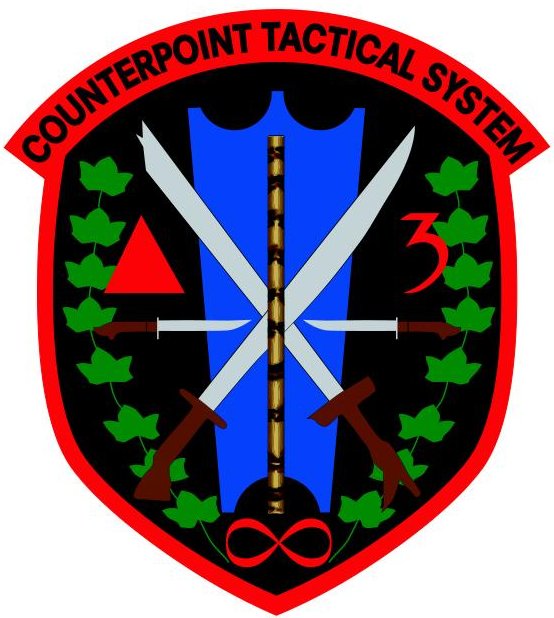About the System
The Counterpoint Tactical System, also known by the acronym CTS, is a weapon-based integrated martial art designed for the street with an emphasis on real-world tactical counter offense. Although an eclectic martial art, the Counterpoint Tactical System's largest traditional influence can be found in the Filipino Martial Arts. The purpose of CTS is to train and certify students and instructors, making them well versed in every phase of civilian armed and unarmed combat. The CTS curriculum is designed with a survival based philosophy and is not intended to be practiced or used as a sport. CTS uses a "Civilian Use of Force Continuum" to help students better understand real world violence and how to appropriately respond to a bad situation.
Being an integrated martial art, CTS uses tactics from various arts based on multiple attackers, weapons, range or strategy to formulate a cohesive curriculum. As the range changes so does the combative tactics. Categories of training include weapons techniques such as single and double stick, knife, staff, gun, and the combination of stick and dagger; and empty hand techniques such as kicking, stomping, striking, punching, trapping, locking, throwing and ground fighting. Concepts of accelerated learning are built into the training process to more quickly advance the student’s combative skill sets. Additionally, CTS uses the concept of “Block Training” where beginner level basics are presented in blocks of material with all subsequent intermediate and advanced training stacking onto earlier foundational blocks. Laterally, training blocks or disciplines fit side by side, and any individual block can attach to or support another. For example, the Pangamot block (empty hands versus stick) can be attached to or developed by other specific blocks such as the striking skills from Kenpo Counterpoint, the locking and throwing skills from the grappling disciplines, or the entry tactics from Eskrido and Panatukan. Therefore through the training and testing process of each block, students develop important skill sets before advancing to connecting blocks and as blocks connect the student’s knowledge and skill mastery grows exponentially.
The 80/20 rule is a concept that is the criterion of all CTS curriculum. This principle says that in most martial art disciplines 80% of the curriculum has 20% of the value and vice versa (20% of the curriculum has 80% of the value). So, as a system, we gravitate to the 20% high value tactics and techniques that are most reliable, effective and functional against experienced fighters. To further enhance the effectiveness of the training process we use the open motor training model. The open motor model sets the student against the active counter pressure of a trained, resisting partner. We do not practice a closed model that uses training partners as mere dummies standing motionless without making an effort to counter. Therefore, drills are limited to only the most effective techniques and are taught as a basis for the student’s learning process and comprehension. Drills must automatically transcend to sparring and to live application. Any techniques, tactics or strategies that are deemed low percentage are discarded.
Some prospective students may ask the question: “I never carry a stick so why should I train with one?” This is a correct assumption as most people don’t carry a stick in public. However, in the real world of violence, bad guys do pick up objects to be used as impact weapons with the intent of doing harm to others. So, in CTS training you will learn a broad range of combat elements that are applicable to survival situations such as; targeting, power generation, three ranges of stick fighting tactics, countering, disarming and weapons retention. Through stick training you will better understand vital targeting of the human anatomy. With a more complete understanding of weapon usage students will be more capable of defending themselves against an actual assault with an impact weapon. Through conditioning with the stick your arms and upper body become, faster and stronger, your joints and connective tissue will become more flexible and resilient. The conditioning that you develop with the extension of a stick in your hand cannot be replicated as effectively through any other method. Advanced trapping skills, entry skills, weapon retention skills, striking, punching, locking, throwing and countering skills are all enhanced by stick conditioning.
Concepts of the mind and body connection are included in the training. Understanding the cause and effect of survival stress and the effects that the autonomic and sympathetic nervous systems have on the human body are crucial in success on the street. Education and conditioning along with mental and physical preparation for these situations are addressed and developed. Breathing disciplines, scenario and awareness training and physical fitness help prepare students of the complexities and reality of the real world of survival stress.
For children the curriculum is minimized and simplified into much smaller and more basic blocks. These blocks focus on specific skills such as rolling and falling, focus mitt drills, grappling basics and stick conditioning. As children develop valuable self-defense skills and continue to progress through the system, then the blocks are gradually developed to a point where children can transition into the adult curriculum with a strong skill set and functioning knowledge of adult level tactics. Actually, a beginning adult will sometimes look to their experienced but younger counterparts for assistance in training.
Please browse through our website to find more information on CTS training and on Counterpoint Tactical International, the governing organization of the Counterpoint Tactical System. Active CTI members also have access to the member’s only page for access to training curriculum documents.




